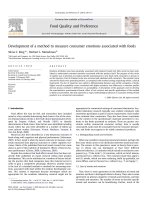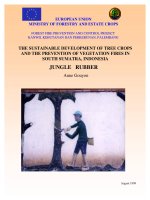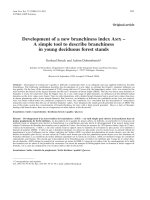Development of extension service utilisation index
Bạn đang xem bản rút gọn của tài liệu. Xem và tải ngay bản đầy đủ của tài liệu tại đây (309.39 KB, 7 trang )
Int.J.Curr.Microbiol.App.Sci (2018) 7(5): 2685-2691
International Journal of Current Microbiology and Applied Sciences
ISSN: 2319-7706 Volume 7 Number 05 (2018)
Journal homepage:
Original Research Article
/>
Development of Extension Service Utilisation Index
B. Neethi* and A. Sailaja
Department of agricultural extension, college of agriculture, Acharya N.G Ranga Agriculture
University, Rajendranagar, Hyderabad, India
*Corresponding author
ABSTRACT
Keywords
Development,
Extension service,
Utilisation index
Article Info
Accepted:
20 April 2018
Available Online:
10 May 2018
Ex- post facto research design was followed for carrying out the study in the State of
Andhra Pradesh. Sample comprise of 120farmers randomly from four randomly selected
mandals of Mahabunagar district which was a purposive selection. Two parameters
namely extent of utilisation and extent of adoption were considered for the construction of
utilisation index. To study the relevance of different aspects of each of DAATTC services
judges were contacted. The aspects under each of the services whose values were more
than one were finally selected. To measure the adoption, recommended practices in cotton
crop were selected to prepare the schedule in consultation with scientists of DAATTC,
teaching staff of college of agriculture, Rajendranagar and officials of state department of
agriculture and other staff. The respondents were asked to respond to each sun item of
adoption of these practices with respect to their extent of adoption of respondents.
Majority of respondents had medium utilisation of services of DAATTC. As there was less
utilisation of services through assessment and refinement of technologies and services
through information centre and supply of information material, the scientists need to assess
and refine the technologies immediately and give feed back to farmers, so that the farmers
get satisfied. To develop the information centre and supply the information material,
sufficient budget has to sanction so that technologies get widely publicized these will
ultimately result in effective service utilisation. Finally, it can be concluded that the
utilisation of DAATTC services helps the farmers in increasing the level of knowledge,
skill and adoption of technology.
Introduction
Extension is a series of embedded
communicative intervention that is meant to
develop or induce innovations which help to
resolve problematic situations. Agriculture is
the most well integrated sector of the economy
throughout the world and agricultural
extension is the nucleus of the agriculture cell.
The development of agriculture is mostly
dependent on the effectiveness of agricultural
extension – its services, methodologies and
processes. Extension network is effective there
reason proper agricultural technology will not
reach to its users for its efficient adoption.
Extension as an essential pillar for research
and development however, unfortunately, a
somewhat unhealthy perception of extension
prevails in many countries, caused by a weak
2685
Int.J.Curr.Microbiol.App.Sci (2018) 7(5): 2685-2691
extension lobby, faulty initial organizational
set-up, an inherent lack of trust in extension
by most of the research organizations and
traditionally poor career development
conditions in profession of extension.
Agricultural research agendas remain largely
academic unless extension workers provide
input in terms of the identified and as – yet
unsolved field problems of the farmers.
Research focusses on the technical aspects for
generating
useful
technologies,
while
extension focuses on the acceptance,
utilisation and finally adoption of technologies
by users.
This study which first of its kind made an
attempt to study the utilization of services
delivery of DAATTC by farmers of different
socio-economic status. This study also enables
to formulate a strategy in effective delivery of
services to enable effective utilization by
farmers, thus it serves as ready-reckoner in
ANGRAU planners to put forth the strategy
into implementation and thus the farming
community.
Materials and Methods
Utilisation of DAATTC services
It is operationalised as extent of utilisation of
services and adoption of a technology by
selected farmers.
For this, a set of aspects was framed to elicit
utilisation of DAATTC services and were
prepared in consultation with the expert
scientists and extensionists.
Construction of the index: Two parameters
namely extent of utilisation and extent of
adoption were considered for the construction
of utilisation index. To study the relevance of
different aspects of each of DAATTC services
judges were contacted.
Extent of utilisation: The following procedure
was followed towards extent of utilisation of
services. The services selected for the study
was those provided by DAATTC were listed
different aspects under each of the services
were formulated. This was given to those
working in various extension units a
comprising of twenty judges. They were
requested to rate each aspect on a three point
continuum according to their relevance
ranging from ‘highly relevant’ (3), ‘relevant’
(2) and ‘not relevant’ (1) with the respective
scores accorded. Frequency of respondents
against each aspect were multiplied with
respective scores, the total scores for each
aspect were worked out and the medium value
of each aspect was arrived at by dividing total
score with number of respondents. The
medium value for each aspect was rounded off
to the nearest integer. These values have been
taken as weights for different aspects. Those
aspects whose medium values were finally one
and less than one were deleted. The aspects
under each of the services whose values were
more than one were finally selected and
enclosed in Table 1.
Those aspects under each of the services
included various items like information
coverage, timeliness, suitability, accessibility
and perception towards past performance. The
respondents were asked to initial respond to
each of these aspects with relevant scores of
two or one accorded. Then they were asked to
state their extent of utilisation on a three point
continuum namely highly utilised (3), partially
utilised (2), less utilised (1) with respective
scores
accorded.
Full
utilisation
is
operationalised as the utilisation of services
regularly in each season in every year by the
respondents to make improvement in one or
all behavioral components namely knowledge,
attitude and skill. Partial utilisation is
operationalised as the utilisation of services at
least once in a year continuously for three
years by the respondents to make
2686
Int.J.Curr.Microbiol.App.Sci (2018) 7(5): 2685-2691
improvement in one or all behavioral
components. Less utilisation is operationalised
as the utilisation of services once in three
years by the respondents to make
improvement in one or all behavioral
components. The final score of a respondent
against each aspect was obtained by adding
these two score i.e., regarding each item of
aspect and extent of utilisation against each of
these aspects.
The maximum score was 198 and minimum
score obtained was 120. The total score of
respondents was arrived by multiplying the
frequency of responses of each aspect of
service with corresponding final score. The
mean score of each aspect of service was
arrived from dividing total score with number
of respondents and aspects were ranked based
on mean scores.
adoption is operationalised as the adoption of
stated practice completely and regularly in
each season of a year continuously for three
year period. Partial adoption is operationalised
as the adoption of only a part or whole of
recommended practice once in year
continuously for three year period. Less
adoption was operationalised as the adoption
of only a part of recommended practice once
in a three years period. Symbolic adoption was
operationalised as the practices over which he
has taken mental decision but not taken up
physical action over them. Non adoption was
operationalised as that recommended practices
were not all adopted by the farmer.
The respondents were grouped into following
three categories i.e. low, medium and high
utilisation of DAATTC services based on
inclusive class interval technique.
The maximum and minimum possible scores
were 200 and 40 respectively. Whereas the
maximum and minimum scores obtained were
160 and 97 respectively. The total score of all
respondents was arrived by multiplying the
frequency of responses under each of the sub
item of practice with corresponding
weightage. The mean score of each sub item
of practice was arrived from dividing total
score with number of respondents and sub
items were ranked based on mean scores.
Extent of adoption
Categorization
Adoption is the acceptance and practical
application of a particular recommended
practice. To measure the adoption,
recommended practices in cotton crop were
selected to prepare the schedule in
consultation with Scientists of DAATTC,
teaching staff of College of Agriculture,
Rajendranagar and officials of State
department of agriculture and other staff. The
respondents were asked to respond to each sun
item of adoption of these practices with
respect to their extent of adoption on a five
point continuum namely ‘full adoption’ (5),
‘partial adoption’ (4), ‘less adoption’ (3),
‘symbolic adoption’ (2), ‘non adoption’ (1)
with respective weightages accorded. Full
The respondents were grouped into following
three categories i.e. low, medium and high
based on inclusive class interval technique.
Categorization
Utilisation of DAATTC services was arrived
by summing up of extent of utilisation and
extent of adoption of respondents. Maximum
and minimum scores obtained were 334 and
247 respectively.
Categorization
The respondents were grouped into following
three categories i.e. low, medium and high
utilisation of DAATTC services based on
inclusive class interval technique.
2687
Int.J.Curr.Microbiol.App.Sci (2018) 7(5): 2685-2691
Table.1 Selection of aspects to measure extent of utilisation of services
S No
I
1
2
3
4
5
6
7
II
1
2
3
4
5
III
1
2
3
4
5
6
7
8
IV
1
2
3
4
5
V
1
2
3
4
VI
A
1
2
3
Services
HR
R
NR TS
Services through assessment and refinement of technology
Coverage of complete information
12
6
2
50
Timeliness of service
4
12
4
40
Opportunity for feed back
14
3
3
51
Consideration of suggestions for refinement of
13
5
2
51
technology
Imparted farming situation based technologies
17
3
0
57
Suitability of service to the respondent
11
5
4
47
Satisfaction of past performance of service
10
7
3
47
Diagnostic services
Coverage of complete information
17
2
1
56
Timeliness of service
16
3
1
55
Need based services
16
2
2
54
Services solves problem
13
6
1
52
Satisfaction of past performance of service
15
1
4
51
Services through information centre and supply of information material
Provision of holistic information
13
2
5
48
Provision of information material
5
11
4
41
Timeliness of service
8
10
2
46
Services solves problem
5
13
2
43
Access to concerned officials
8
8
4
44
Suitability of service to the respondent
6
9
5
41
Trustworthy of Service
12
6
2
50
Satisfaction of past performance of service
2
8
10 32
Services through training programmes
Provision of complete information
7
3
10 37
Timeliness of service
8
2
10 38
Need based services
10
7
3
47
Suitability of service to the respondent
11
4
5
46
Satisfaction of past performance of service
13
3
4
49
Services through RAWEP students
Provision of complete information
12
3
5
47
Timeliness of service
9
4
7
42
Suitability of service to the respondent
5
6
9
36
Satisfaction of past performance of service
11
3
6
45
Technology transfer
Technology aspects
Imparted simple technology
15
4
1
54
Disseminated affordable technology
13
7
0
53
Trialability of technology
9
7
4
45
2688
MS
MS
2.50
2.00
2.55
2.55
3
2
3
3
2.85
2.35
2.35
3
2
2
2.80
2.75
2.70
2.60
2.55
3
3
3
3
3
2.40
2.05
2.30
2.15
2.20
2.05
2.50
1.60
2
2
2
2
2
2
3
2
1.85
1.90
2.35
2.30
2.45
2
2
2
2
2
2.35
2.10
1.80
2.25
2
2
2
2
2.70
2.65
2.25
3
3
2
Int.J.Curr.Microbiol.App.Sci (2018) 7(5): 2685-2691
4
5
B
1
2
3
4
5
6
7
VII
1
2
3
4
5
6
Technology observability
Technology replicability
Ways and means of technology transfer
Utilisation of group meetings
Utilisation of kisan meals
Utilisation of study tours
Utilisation of field days
Utilisation of minikit trials
Utilisation of demonstrations
Utilisation of exhibitions
Other services
Provision of market intelligence
Mechanization aspects covered
Details of input source availability
Orientation to own input production
Relevance of services to climatic change
Information on natural resources management
12
14
2
2
6
4
46
50
2.30
2.50
2
3
7
9
8
14
11
12
11
12
9
10
3
7
6
4
1
2
2
3
4
2
5
46
46
45
49
48
49
42
2.30
2.30
2.25
2.45
2.40
2.45
2.10
2
2
2
2
2
2
2
11
4
5
6
4
9
4
14
13
10
10
12
5
2
2
4
6
1
46
42
43
42
38
52
2.30
2.10
2.15
2.10
1.90
2.60
2
2
2
2
2
3
Table.2 Distribution of respondents based on extent of utilisation of services
n=120
S. No.
Category
1
2
3
Low
Medium
High
Respondents
Frequency
Percentage (%)
15
12.50
72
60.00
33
27.50
Table.3 Distribution of respondents based on extent of adoption in cotton
n=120
S. No.
1
2
3
Category
Low
Medium
High
Respondents
Frequency
19
86
15
Percentage (%)
15.83
71.67
12.50
Table.4 Distribution of respondents based on their utilisation of DAATTC services
n=120
S. No.
1
2
3
Category
Low
Medium
High
Respondents
Frequency
21
75
24
2689
Percentage (%)
17.50
62.50
20.00
Int.J.Curr.Microbiol.App.Sci (2018) 7(5): 2685-2691
Category of utilization
Category of utilization
Low
Medium
High
Range
120-146
146-172
172-198
Category of adoption
Category of adoption
Low
Medium
High
Range
97-118
118-139
139-160
Category of utilisation
Category of utilisation
Low
Medium
High
Range
247-276
276-305
305-334
Total obtained scores on all items on extent of
utilisation and adoption
Utilisation index = ------------------------- × 100
Maximum possible scores on all items on extent
of
behaviour, medium social participation and
medium participation in DAATTC activities.
Results and Discussion
It could be indicated from the Table.3 that
majority (71.67%) of the respondents had
medium adoption in cotton followed by low
(15.83 %) and high (12.50%). The medium
extent of adoption of recommended practices
was observed because of less opportunity for
feedback and consideration of farmers’
suggestions for refinement of technologies.
Utilisation of services of district agricultural
advisory and transfer of technology centre by
farmers
Extent of utilisation
It could be indicated from the Table.2 that
majority (60.00%) of the respondents had
medium extent of utilisation of services
followed by high (27.50%) and low (12.50%)
utilisation of services.
It could be inferred that majority of the
respondents had medium extent of utilisation of
services due to illiteracy, small farm size,
medium
annual
income,
medium
innovativeness, medium information seeking
Extent of adoption
practices in cotton
of
recommended
Utilisation of DAATTC services
It could be indicated from the Table.4 that
majority (62.50%) of the respondents had
medium utilisation of DAATTC services
followed by high (20.00 %) and low (17.50%)
utilisation of DAATTC services.
The above finding can be attributed to medium
extent of utilisation (Table 1) and medium
extent of adoption (Table 2). Utilisation index is
2690
Int.J.Curr.Microbiol.App.Sci (2018) 7(5): 2685-2691
calculated as per formula given in methodology
and given under.
334
Utilisation index = ------------ × 100 = 76.78%
435
Thus, it can be noted that DAATTC has
provided indefatigable services for the
respondents.
As majority of farmers felt that as observability
of slow moving i.e., maintenance of refugee
crop, seed treatment, bio fertilizer applications,
biological control measures usage in cotton crop
was less, so was their adoption.
Hence, DAATTC scientists and other
stakeholders have to concentrate on these
aspects by creating awareness among the
farmers, finally convince them through media
mix of demonstrations, field days, minikit trials,
video presentations and conducting group
meetings regularly in model farm of innovative
farmers fields. For innovative farmers
honorarium should be paid as they in turn train
20 master trainers in mandal to train farmer
friends of ATMA who in turn trains farmer
interest groups of ATMA at village level.
Hence, DAATTC has to link up with the
ATMA network in transfer of technology.
Moreover, exposure visits to successful fields
was suggested by farmers in the study. This
method may be considered and innovative
farmers may be utilised for this purpose.
Timely follow up of each and every technology
transferred was most important to be attended
by DAATTC scientists to facilitate technology
assessment and refinement which helps in
effective utilisation.
References
Chinchamalapure, U.R., Rajput, H.D and Girase,
C.P. 2009. Utilisation, credibility and
effectiveness of communication media
among Bt cotton growers. Journal of
Agricultural Extension Management. 10(2):
99-104.
Desai, G.R and Manohari, P.L. 2009. Utilisation
of animal husbandry extension services by
rainfed farmers. Journal of Agricultural
Extension Management. 10 (1): 37-45.
Desai, G.R., Manohari, P.L and Kumar, T.D.S.,
2009. Utilisation of agricultural research
and extension services by rainfed farmers.
Journal
of
Agricultural
Extension
Management. 10 (1): 1-11.
Kotele, R, T., Suradkar, D.D and Bhople. 2009.
Determinations of utility perception of
telecast agricultural technologies. Journal of
Agricultural Extension Management. 10
(2): 71-76.
Kumar, B. Asokhan, M., Palaniswamy, S and
Ravichandran, V. 2012. Utilization
behaviour of potato growers between cooperative and private cold storage unit.
Journal of Extension Education. 24 (1):
4755-4760.
Manohari, P.L. 2002. Utilisation of information
sources by the tribal farmers in
Rampachodavaram agency area - A micro
study. Manage Extension Research Review.
3(2): 132-136.
Rao, I.S. 1995. Perception of mango growers
about utility of fruit research station
Sangareddy. Journal of Research. 23(3):3133.
Sendilkumar, R., Fernandaz, C.C., Karpagam, C
and Asokhan, M. 2010. Farm front
extension services at the Uzhavar
Udhaviyagam- A formative evaluation.
Journal of Extension Education. 22 (1):
4357- 4365.
How to cite this article:
Neethi, B. and Sailaja, A. 2018. Development of Extension Service Utilisation Index.
Int.J.Curr.Microbiol.App.Sci. 7(05): 2685-2691. doi: />
2691









